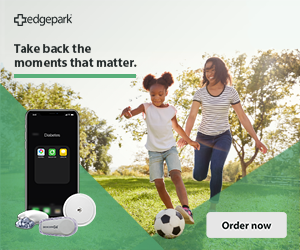Supporting the highs and lows of living with type 1 diabetes
When someone asks me what living with type 1 diabetes (T1D) is like, I sometimes struggle to find the right words or a proper analogy. This condition is often all-consuming and invisible at the same time.
The part you see from the outside — all those finger pricks and insulin injections — is only half the story. Dealing with the mental aspect of this disease can be even more challenging than the physical manifestations. The need to constantly course-correct friends and family due to misinformation, misconceptions or stigma can add to the mental challenge.
Fortunately, there are ways to make things easier for individuals with T1D. If you know someone who lives with the disease, here are a few tips for being as supportive and helpful as possible.
Give conversation a "shot"
The first step in supporting your friend or family member with type 1 diabetes is to initiate a dialogue. It's important to tread carefully here, as everyone has a different comfort level when discussing diabetes topics.
A good starting place may be simply asking about the physical aspects they deal with and the parts of the disease you can see. When the time is right, asking open-ended questions can help frame your curiosity and demonstrate how much you care. For instance, asking, "Is that an insulin pump? How does it work?" or "How often do you test your blood sugar? Does it hurt?" can form a natural bridge between the physical aspects and the sometimes invisible parts of the disease. You can then follow up with questions such as, "What does being low feel like?" or "What do I need to get you if you say you have high blood sugar?"
My top tip for diabetes discussions: Don't assume anything! It's easy to fall into the trap of wanting to relate your connection to diabetes by sharing things such as, "My grandma had diabetes and went blind" or asking, "My uncle has diabetes and just takes a pill, can't you do that?" It's best to avoid statements and questions like this.
There are several types of diabetes, and even within a specific type, like type 1 diabetes, there are various management methods. Some people with T1D thrive with multiple daily injections via a syringe or insulin pen, while others prefer to use an insulin pump. And some folks with T1D may find tight control is easier to manage with a low carbohydrate diet, while others need a lot of carbohydrates to perform at a high level (or just because they want to).
Work to identify the highs and lows
When looking to support someone with type 1 diabetes, it helps to understand the fundamentals of the disease: low and high blood sugars. Hypoglycemia (also known as low blood sugar) can occur when an individual's blood glucose levels drop below a healthy range. This is often the result of physical activity, incorrect insulin dosing or missing a snack or meal. Since glucose is the body's main source of energy, the physical signs of low blood sugar are shakiness, sweating, brain fog and extreme hunger. As a support person, be ready to serve up some juice, soda (not the diet variety) or anything with fast-acting carbohydrates!
Hyperglycemia (also known as high blood sugar) occurs in the opposite situation, when the blood has too much glucose. Signs of high blood sugar include irritability, extreme thirst and frequent urination. In general, high blood sugar events have a longer ramp-up time than hypoglycemia — but it doesn't make them any less serious! To bring blood sugar levels down, a person with type 1 diabetes must take an insulin injection or dial up a bolus on their insulin pump. If high blood sugar levels are slow to decrease, it's best to use a method other than an insulin pump to deliver the insulin as it's possible the pump could be malfunctioning.
Bust existing T1D myths
Aside from providing care and support for family or friends who have type 1 diabetes, you can also make a difference by busting myths about the condition. There is often a lot of confusion surrounding diabetes, so it helps to set people straight whenever possible!
Here are two of the most common misunderstandings you may run into:
Myth #1: Everyone with T1D is the same. Type 1 diabetes is a dynamic disease. Small changes in environment, sleep patterns, exercise regimens, stress levels, relationships, hormones, temperature and basically everything else can affect your loved one's numbers. Eating the same number of carbohydrates each meal does not guarantee that a person will require the same dose of insulin. Mixing carbohydrates with other nutritional values such as protein and fat can change a meal's effective carbohydrates and therefore require different insulin dosing.
Additionally, women with the disease are uniquely affected, both by the time of the month and even more significantly during pregnancy when insulin ratios change almost daily. Even with over 20 years of experience under my belt, I am still constantly noticing new trends and tweaking variables to tighten up my control!
Myth #2: Type 1 diabetes technology can provide a cure. There is currently no cure for type 1 diabetes. Technology can help us maintain tighter control and reduce the number of equations we are balancing, but an insulin pump or continuous glucose monitor (CGM) is not a cure for this condition. As of now, these machines require user input, occasionally in the form of ratios or target ranges — and constantly in the form of carbohydrate counts.
And while these devices have been shown to positively affect the overall health and well-being of people with T1D, sometimes it's best to simply go back to basics. Many diabetes technology resources come with the disclaimer that if the patient is feeling different than their readings reflect, they should opt for old-fashioned blood sugar checks or inject insulin with a syringe instead of the insulin pump.
Beyond attempting to research every tiny nuance of living with type 1 diabetes, you should ultimately focus on simply being kind and genuine. A foundation of trust will organically cultivate deeper diabetes discussions and ultimately, the perfect support system for your friends and family with the condition.
Interested in learning other ways to provide care and support for your loved ones with diabetes? Visit the Edgepark website to browse continuous glucose monitor (CGM) devices, testing supplies, helpful accessories and valuable insights.




